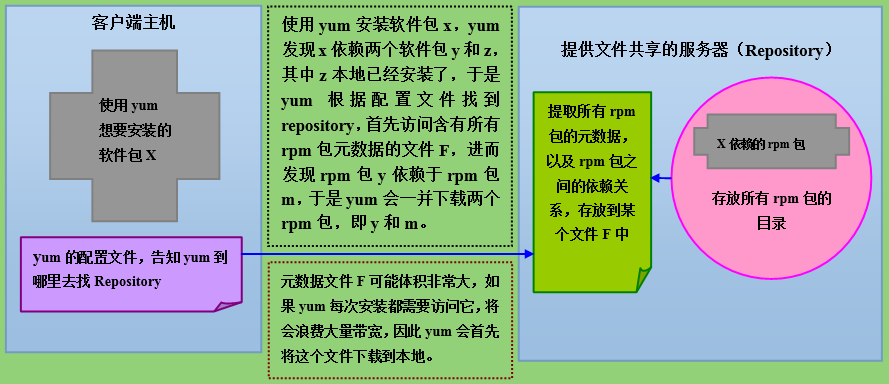一、yum的工作原理
yum是一个RPM包的前端管理工具,在rpm包的依赖关系已经被建成数据库的前提下,它能够实现自动查找相互依赖的rpm包,并从repository中下载互相依赖的rpm包到本地。
二、如何建立yum的仓库repository
如果yum和repository不在同一台主机上,那么能够为yum提供repository仓库服务的远程服务器协议通常有两类:(1)ftp://(2)http://
如果yum和repository在同一台主机上,那么yum就可以直接到某个目录中提取rpm包,而为了和远程服务器形成统一的风格,也会使用一个传输协议:file:///,因此如果仓库建在根目录/下,那么就可以使用file:///yum/这个路径来提取文件。
yum仓库的建立,需要分成服务端和客户端两部分:
A.服务端
将所有需要用到的rpm包存放于某个目录之下,该目录可以是远程的(采用ftp和http协议),也可以是本地的(采用file协议)。目录建立好了之后,使用createrpo命令来提取目录下所有rpm包的元数据和依赖关系,生成一些xml格式的文件,这些xml文件会存放在repodata目录下,至此,服务器端的repository就建立好了。注意repodata所在的位置,就是yum仓库的位置(主要针对红帽6,红帽5的repository会分成4个目录,每个目录下都有一个repodata)。

B. 客户端
客户端的配置非常简单,只需要使用yum及其子命令install、reinstall或remove即可。不过使用yum及其子命令之前,需要编辑配置文件,以告知yum命令仓库repository在什么地方。这个配置文件为:/etc/yum.conf。此外/etc/yum.repos.d/*.repo都被视为/etc/yum/conf的组成部分。
下面来查看一下/etc/yum.conf:
[root@localhost ~]# vim/etc/yum
yum/ yum.conf yum.repos.d/
观察yum.conf文件,其中中括号是用来做仓库定义的,中括号里的内容,即为仓库的名称,但是main除外,main是为其他仓库提供默认配置的。仓库可以有多个,但是main(全局配置)只有一个
[root@localhost ~]# vim/etc/yum.conf
[main] # 全局配置,为其他仓库定义默认值 cachedir=/var/cache/yum/$basearch/$releasever # 缓存目录为/var/cache/yum/$basearch/$releasever keepcache=0 # rpm包是否需要在本地长久保存 debuglevel=2 # 调试级别,运行过程中的信息是否需要显示 logfile=/var/log/yum.log # 日志文件,记录yum命令安装过的文件,执行过的操作等等,供以后检索使用 exactarch=1 # 下载的软件包是否需要和本地平台完全匹配(1表示是,0表示否) obsoletes=1 gpgcheck=1 # 下载rpm包之前是否需要自动进行来源(签名)合法性检测,1表示要检查。 plugins=1 installonly_limit=5 bugtracker_url=http://bugs.centos.org/set_project.php?project_id=16&ref=http://bugs.centos.org/bug_report_page.php?category=yum distroverpkg=centos-release # This is the default, if you make this bigger yum won‘t see if the # metadata is newer on the remote and soyou‘ll "gain" the bandwidth of not# having to download the new metadata and"pay" for it by yum not having # correct information. # It is esp. important, to have correct metadata, for distributions like # Fedora which don‘t keep oldpackages around. If you don‘t like this # checking interupting your command lineusage, it‘s much better to have # something manually check the metadataonce an hour (yum-updatesd will # do this). metadata_expire=90m # PUT YOUR REPOS HERE OR INseparate files named file.repo # in /etc/yum.repos.d
如果要定义yum的仓库,可以在/etc/yum.repos.d下新建一个以repo结尾的文件:
[root@localhost ~]# cd/etc/yum.repos.d/
[root@localhost yum.repos.d]#ls
CentOS-Base.repo CentOS-Debuginfo.repo CentOS-Media.repo CentOS-Vault.repo # CentOS-Base.repo是最终会生效的配置文件,建议先备份,然后对其进行修改
配置文件的主要内容有:
[Repository_ID] ——仓库的ID,可以取任意名字,只要不和其他的ID冲突即可
name=... ——仓库的描述信息,长短不限,可以有空格,但是必不可少
baseurl=url ——告诉yum客户端,通过哪种路径可以访问到
enabled={1|0} ——是否启用这个仓库,0表示不启用,1表示启用,默认是启用的
gpgcheck=1{1|0} ——是否进行签名合法性检测,0表示不启用,1表示启用,默认启用。
如果选择启用gpg检查,则需要告知其key是什么。
gpgkey=url ——如果启用gpg检测,则需要指定gpgkey的路径,即使导入过gpgkey,
这里仍然需要手动为其指定路径,这个路径可以是远程服务器上的,
也可以是本地的,只要让本地客户端访问到即可。
cost=1000 ——访问的代价,定义了cost的,且数字较小的,会被优先访问。
如果两个仓库里的RPM包是一样的,一个在远程服务器上,另一个在本地光盘上,那么本地光盘的访问速度通常会快于远程服务器上。在配置文件中,我们可以定义这样的两个仓库,为其中一个设定优先级
下面来配置一个仓库。为了避免其他的仓库扰乱当前要定义的仓库,在配置之前,先编辑一下原有的CentOS-Base.repo文件:
[root@localhost yum.repos.d]#vim CentOS-Base.repo
[base] name=CentOS-$releasever - Base mirrorlist=http://mirrorlist.centos.org/?release=$releasever&arch=$basearch&repo=os #baseurl=http://mirror.centos.org/centos/$releasever/os/$basearch/ gpgcheck=1 gpgkey=file:///etc/pki/rpm-gpg/RPM-GPG-KEY-CentOS-6 enabled=0 name=CentOS-$releasever - Base mirrorlist=http://mirrorlist.centos.org/?release=$releasever&arch=$basearch&repo=os #baseurl=http://mirror.centos.org/centos/$releasever/os/$basearch/ gpgcheck=1 gpgkey=file:///etc/pki/rpm-gpg/RPM-GPG-KEY-CentOS-6 enabled=0 # 将这个仓库禁用即可
[root@localhost yum.repos.d]#vim base.repo
[base] name=CentOS 6.4 x86_64 baseurl=http://mirror.centos.org/centos/6.5/os/x86_64/ enabled=1 gpgcheck=0
下面来检测已经配置好的repository是否可以正常使用:
[root@localhost yum.repos.d]#yum list all | less # list命令可以用来查看仓库里的程序包,后文会详解,这里只做检测用 Failed to set locale, defaulting to C Loaded plugins: fastestmirror, refresh-packagekit, security Repository base is listed more than once in theconfiguration Loading mirror speeds from cached hostfile Installed Packages ConsoleKit.x86_64 0.4.1-3.el6 @anaconda-CentOS-201311272149.x86_64/6.5 # 软件包名称.平台版本 版本号-发行号 @anaconda表示系统已经安装了,来自于那个yum仓库 ConsoleKit-libs.x86_64 0.4.1-3.el6 @anaconda-CentOS-201311272149.x86_64/6.5 ConsoleKit-x11.x86_64 0.4.1-3.el6 @anaconda-CentOS-201311272149.x86_64/6.5 apr.i686 1.3.9-5.el6_2 base # base表示该程序在base仓库中,还没有安装 apr-devel.i686 1.3.9-5.el6_2 base apr-devel.x86_64 1.3.9-5.el6_2 base apr-util.i686 1.3.9-3.el6_0.1 base
可以使用yum命令查看repository里的包,说明仓库已经建好了。
